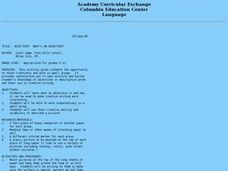Alabama Learning Exchange
"Batty" About Bats!! (Writing)
Young writers identify the characteristics of a bat and write an essay about bats. They construct a book about bats that includes information that they have learned through print materials and online resources.
Curated OER
Figuratively Writing...It's for the Birds!
Learners identify and use literary devices such as personification, idioms, hyperbole, and metaphors. They identify one literary device and illustrate the meaning. They write a letter using correct letter format and incorporates literary...
Curated OER
Click! Writing Through Digital Photography
Young scholars take their own digital photographs and scan them onto the computer. For each photograph, they write about them and use the internet to research their subject in the photo more throughly. They are graded based on a rubric...
Curated OER
Let's Write Invitations for our Class Celebration
Students examine the parts of a letter and a written invitation. They write letters inviting family members to a classroom celebration.
Curated OER
The Poetry Archive
Learners discover how to express their feeling poetically. In this poetry instructional activity, students discuss their feelings, descriptive language to describe these feelings, and create poems.
Curated OER
"Name Game" Poetry
Students write a poem by choosing a word and then creating a poem out of the individual letters of their word. They brainstorm words for each letter of their poem then create it and publish it using a word processor.
Novelinks
Oedipus the King: Biopoem
The biopoem is a great way for instructors to get to know class members, classmates to get to know each other, and readers to flesh out their understanding of a character. Why not create a biopoem for a character from Oedipus the King?
Curated OER
Recycling
Students read or listen to a story, and discuss how it relates to them. In this personal event writing activity, students write about recycling. Students read "The Giving Tree" a Shel Silverstein poem and discuss the poem's meaning....
Curated OER
Dinosaur Stomp
Second graders write a dinosaur poem using information from a research activity. In this dinosaur poetry and music lesson, 2nd graders listen to the book Saturday Night at the Dinosaur Stomp in music class. They work in small groups to...
Curated OER
Hailstones & Halibut Bones: Using Color to Teach Adjectives
Students write original color poems based on the poems in the book, "Hailstones and Halibut Bones." They select a color, develop a list of adjectives and characteristics, write a poem, and create a drawing.
Curated OER
A Poetic Finale
Students write a poetic response to the Holocaust as a culminating activity to a unit on the Holocaust. They listen to and discuss a rap song about the Holocaust, complete various handouts, and write a poem for future generations.
Curated OER
Clay Story Adventure
Students build three-dimensional rough draft for a story by creating objects, people, places, animals, etc., with clay, and write story in a journal, poem, or other written form.
Curated OER
Power Totem
Students investigate the important symbols to Native cultures by writing a poem. In this animal totem lesson, students discuss animal spirits and their relation to the Native American lifestyle. Students write a cinquain poem about a...
Curated OER
Adopt a Tree
First graders describe the characteristics of a tree. In this science instructional activity, 1st graders create predictions about a book they will be listening to, Have you Seen Trees. Additionally, students describe their trees using...
Curated OER
Adjective? What's an Adjective?
Mount a variety of pictures (fantasy, rustic, portraits, action) on large sheets of paper and post them around the classroom. Groups rotate from poster to poster, adding adjectives to describe each of the pictures. Writers use these word...
Teachers.net
Figurative Language
When is a staple remover a fanged monster? In your ELA classroom when you're teaching this fun figurative language instructional activity, of course! Get your young writers using figurative language by making a game of it. Give groups a...
Curated OER
The First World War
Students examine the process and effects of World War I on different segments of the population, beyond the political, diplomatic and military framework of the war. They analyze the memoirs of soldiers, read poetry of the time, and...
Curated OER
Beautiful Ohio
Third graders read the poem, Beautiful Ohio, discuss it and then write their own descriptive songs/ poems about nature and the environment.
Curated OER
Ornithology and Real World Science
Double click that mouse because you just found an amazing lesson! This cross-curricular Ornithology lesson incorporates literature, writing, reading informational text, data collection, scientific inquiry, Internet research, art, and...
Curated OER
Do You Haiku? We Do!
Third graders try their hands at writing Haiku, a form of Japanese poetry. Haiku is usually 17 syllables in three-line form. This engaging lesson has many excellent worksheets and website imbedded in the plan. They share their finished...
Curated OER
Play with Words: Rhymes & Verse
Students listen to poems and rhymes, clap out syllables, and sing along with familiar tunes. They use puppets and crafts to help recall and retell favorite poems, and craft their own poems.
Curated OER
A New Life, a New Home
Students connect with an immigration unit through research, journal writing, digital photography, and a movie production using iMovie. By acting out the immigrant's experience, students gain a deeper understanding and appreciation of...
Curated OER
Carl Sandburg's "Chicago": Bringing a Great City Alive
Carl Sandburg composed poetry that conveyed a time and place in American Literature and history. Learners identify the literary techniques he uses to describe the historical and cultural context of living in Chicago. They define the...
Curated OER
Carl Sandburg's "Chicago": Bringing a Great City Alive
Students examine the historical and cultural context in Sandburg's poem. The poetic devices of personification and apostrophe are utilized in the poem and identified by Students.

























